Amphibolite
Amphibolite is a rock formed by the metamorphosis of mafic igneous rocks such as basalt, gabbro or diorite. The transformation takes place at moderate to high temperatures (500 to 800 °C) and a wide spectrum of pressures at depths of 10 to 30 km beneath Earth surface. The rock name refers to the mineral amphibole, which together with plagioclase, are the main constituents of this rock. Alternating bands of light-coloured plagioclase with dark-coloured amphibole bands gives the rock a characteristic stripped appearance. The prevailing colour is usually black, blackish green, or dark green.
In the area of Mariánské Lázně, Prameny, and Bochov is a group of rather exotic rocks known as Mariánské Lázně metabasite complex. Amphibolites, eclogites, and serpentinites formed from the metamorphosis of peridotites, basalts, and gabbros. These "protoliths" were once parts of oceanic crust and the uppermost layer of Earth mantle that later were metamorphosed during collision of continents leading to Hercynian (Variscan) orogenesis during the Upper Paleozoic.
Amphibolites are relatively common rocks. Their hardness and workability lends them to be used frequently as construction stone. They were also used as the blades of stone-axes during Paleo to Neolithic times.
Sample donated by the company Agrowild Nová Ves Ltd.
Rock type
Locality
Age

Parkování Goethova vyhlídka
Zaparkovat můžete na přírodním parkovišti (16 míst) vzdáleném cca 300 m od vyhlídky. Dále na určených zpevněných plochách podél cest, kromě křižovatek, výhyben, odboček (nutné ponechat průjezd pro hasiče, záchranáře a kamiony se dřevem).
Parkovacích míst v letní sezóně většinou není dostatek. Doporučujeme využít autobusovou dopravu. Nejkratší možností přístupu je vyjít ze zastávky autobusů MHD č. 8 Hůrky asi 1,2 kilometru vzhůru Gogolovou stezkou.
Kavárna a rozhledna
- Pá
- 11:00 – 17:00
- So - Ne
- 10:00 – 17:00
Vstup na rozhlednu je možný pouze za příznivého počasí.
V případě dotazů nás prosím kontaktujte




